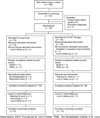Combined Cognitive-Strategy and Task-Specific Training Improve Transfer to Untrained Activities in Subacute Stroke: An Exploratory Randomized Controlled Trial
- PMID: 25416738
- PMCID: PMC4440855
- DOI: 10.1177/1545968314558602
Combined Cognitive-Strategy and Task-Specific Training Improve Transfer to Untrained Activities in Subacute Stroke: An Exploratory Randomized Controlled Trial
Abstract
Purpose: The purpose of this study was to estimate the effect of the Cognitive Orientation to daily Occupational Performance (CO-OP) approach compared with usual outpatient rehabilitation on activity and participation in people <3 months poststroke.
Methods: An exploratory, single-blind, randomized controlled trial, with a usual-care control arm, was conducted. Participants referred to 2 stroke rehabilitation outpatient programs were randomized to receive either usual care or CO-OP. The primary outcome was actual performance of trained and untrained self-selected activities, measured using the Performance Quality Rating Scale (PQRS). Additional outcomes included the Canadian Occupational Performance Measure (COPM), the Stroke Impact Scale Participation Domain, the Community Participation Index, and the Self-Efficacy Gauge.
Results: A total of 35 eligible participants were randomized; 26 completed the intervention. Post intervention, PQRS change scores demonstrated that CO-OP had a medium effect over usual care on trained self-selected activities (d = 0.5) and a large effect on untrained activities (d = 1.2). At a 3-month follow-up, PQRS change scores indicated a large effect of CO-OP on both trained (d = 1.6) and untrained activities (d = 1.1). CO-OP had a small effect on COPM and a medium effect on the Community Participation Index perceived control and on the Self-Efficacy Gauge.
Conclusion: CO-OP was associated with a large treatment effect on follow-up performances of self-selected activities and demonstrated transfer to untrained activities. A larger trial is warranted.
Trial registration: ClinicalTrials.gov NCT01309165.
Keywords: Cognitive Orientation to daily Occupational Performance; cognition; participation; rehabilitation; self-efficacy; stroke.
© The Author(s) 2014.
References
-
- Appelros P, Samuelsson M, Karlsson-Tivenius S, Lokander M, Terent A. A national stroke quality register: 12 years experience from a participating hospital. Eur J Neurol. 2007;14(8):890–894. - PubMed
-
- Brock K, Black S, Cotton S, Kennedy G, Wilson S, Sutton E. Goal achievement in the six months after inpatient rehabilitation for stroke. Disabil Rehabil. 2008:1–7. - PubMed
-
- Mayo NE, Wood-Dauphinee S, Cote R, Durcan L, Carlton J. Activity, participation, and quality of life 6 months poststroke. Arch Phys Med Rehabil. 2002;83(8):1035–1042. - PubMed
-
- van der Zee CH, Visser-Meily JM, Lindeman E, Jaap Kappelle L, Post MW. Participation in the chronic phase of stroke. Top Stroke Rehabil. 2013;20(1):52–61. - PubMed
Publication types
MeSH terms
Associated data
Grants and funding
LinkOut - more resources
Full Text Sources
Other Literature Sources
Medical
Miscellaneous


